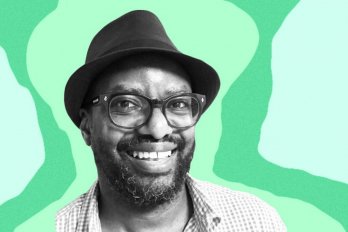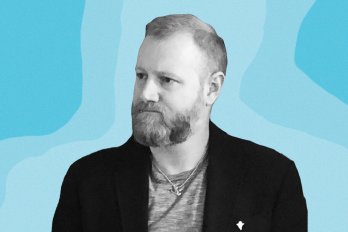One day, a thirty-year-old woman who has been in a blissful relationship with a thirty-six-year-old man for the past three months wakes up in his double bed and decides that although she cares about this person very much, and although she loves his taste in films, books, and music, something is not right. She stares at his messy black hair and creamy skin as he sleeps. She wants to love him because he is a wonderful person, and she cares for him deeply. She wants to wake him up and be happy, but she just can’t. She isn’t sure of the reason why. In the pit of her belly, she feels the same hollow sensation that she has felt in each of her romantic relationships ever since a first French kiss with a boy when she was fourteen years old. She’d hoped she wouldn’t feel it with this boyfriend, but again, there it is. At a New Year’s Eve party in a Toronto warehouse a few weeks later, she cheats on him, and although she is ashamed, the kiss with another woman tells her what she needs to know. The next night, she breaks up with her boyfriend.
That story happens to be mine, but it is also a pretty generic arc when it comes to the phenomenon known as “the late-blooming lesbian.” It’s a common trajectory to go from being with a man to feeling something is wrong to having a eureka moment at the point of sexual contact with a woman. This narrative came to prominence in popular culture in the 2000s with a number of high-profile women coming out, including Meredith Baxter, Portia de Rossi, and Cynthia Nixon. It frequently crops up in lesbian literature and film, forming the backbone of offerings as diverse as Jane Rule’s Desert of the Heart, Alice Walker’s The Color Purple, and queer movies such as Ammonite and Carol.
But this narrative is much more than a proven plot line; it’s important to how gay women see themselves, their lives, and their purpose. “It is the moment of it being so right,” says Kate Johnston, queer activist and co-director of the award-winning movie Tru Love. In that moment of rightness, the protagonist chooses their romantic partner in defiance of possible censure by an often homophobic society. The stories of late-blooming lesbians offer a vision of shared suffering—the months, years, and sometimes decades of confusion—that is transcended when women understand and accept their true selves.
And this narrative has been hard won. “It has been extremely politically important historically, and I think to a certain extent still now, to think about sexual preference and sexual orientation in particular as something fixed,” Amia Srinivasan said on an episode of the podcast The Ezra Klein Show in 2021. Srinivasan is the Chichele professor of social and political theory at All Souls College in the University of Oxford and author of The Right to Sex: Feminism in the Twenty-First Century. “People had to fight very hard, especially gay and lesbian people, to protect their sexual lives, their identities, their practices, their partners from the moral inquisition of a dominant heterosexual culture that wanted to see them as aberrations who could be fixed.”
I came out as a lesbian during the 2010s, and I, too, saw the late-blooming narrative as central to my identity. But I also began to wonder what might be behind it and whether it was really necessary. Is there something about lesbian sexuality that makes coming out an inevitably difficult and prolonged process? Could science explain what was happening?
It is a question that has divided the LGBTQ2+ community. At the heart of the dispute is the nature of queer choice and the extent to which we choose who we (finally) get to be.
The first major studies of lesbianism emerged in the 1990s. (Most of the research, especially the older studies, tends to exclude transgender people and assume binary categories. In the 1970s and ’80s, most researchers did not study bisexuality seriously, and it was perceived in much of the literature as a transitional stage toward identifying as either straight or gay.) In 1993—the same year that American television saw one of its first sapphic kisses, on the show Picket Fences—a seminal study, “‘Coming Out’ in the Age of Social Constructionism: Sexual Identity Formation among Lesbian and Bisexual Women” by Paula C. Rust, was published in Gender and Society. Citing scientific literature from the 1970s and ’80s, Rust noted that “research on gay men indicates that they experience [homosexual arousal] at younger ages and more rapidly than lesbians.” More recently, Pew Research Center broke it down by age. A study published in 2013 reported that 38 percent of gay men first sensed they might not be straight when they were younger than ten, compared to 23 percent of lesbians. Fourteen percent of lesbians said they first thought they might not be straight when they were in the oldest category—age twenty or above—compared to 3 percent of gay men.
Wading into this contested territory is Meredith Chivers, one of the leading researchers of female sexuality in North America and known for bold hypotheses and unconventional methodology. Since 1998, Chivers has been doing research with plethysmographs, devices that measure sexual arousal through increased blood flow. For her 2007 study, at the Centre for Addiction and Mental Health in Toronto, she asked men and women of various sexual identities to affix plethysmographs to their genitalia. Participants were grouped into four categories: homosexual men, heterosexual men, homosexual women, and heterosexual women. She gave them a keypad so they could report their level of sexual arousal. Then, on a computer monitor, she showed them film clips that were both sexual and non-sexual in nature, the former including male and female masturbation as well as intercourse between males, between females, and between males and females.
In general, the men’s responses were pretty straightforward. Heterosexual men had significantly greater responses, in both their self-reports and on the plethysmograph, to clips that featured women. Homosexual men showed similar consistency: they were much more physically turned on by videos of men and reported as much. The women’s responses were more complicated. Heterosexual women reported roughly the same levels of arousal to female and male videos. Homosexual women reported greater response to clips that featured women and some response to those that featured men. But the plethysmographs revealed a different story: both gay and straight women showed statistically significant responses to nearly all types of pornography.
Chivers’s work was published internationally and considered ground-breaking for two reasons. First, it implied that female sexuality, which had historically been ignored, deserved more attention in the lab because what women said turned them on and what was actually revealed by the plethysmographs were sometimes two different things. (Traditionally, sex researchers have relied on tools, such as written questionnaires, that depend on respondents’ clarity and honesty about their own desires.) And second, it offered some possible insight into why a woman may begin to identify as a lesbian later in life. “The fact that women have this capacity to respond sexually to a broad range of things means that the late-blooming lesbian might stay in a straight relationship for many years without realizing anything is missing,” Chivers explains. “Sexual flexibility may be, in part, facilitated by a broader range of sexual response.”
Is there something about lesbian sexuality that makes coming out an inevitably difficult and prolonged process?
Historically, science has gotten the study of lesbianism so wrong. In the late-nineteenth century, queerness was medicalized and marked as “a kind of illness or aberration in the body,” says Hannah McGregor, an associate professor of publishing at Simon Fraser University who studies social change. A medical dictionary published in 1901 defined homosexuality as “abnormal or perverted appetite toward the opposite sex.” According to the book Making Normal: Social Regulation in Canada, by the end of the Second World War, heterosexuality had “achieved dominance as the way of organizing erotic, emotional, and reproductive life.” Meanwhile, psychoanalytic theories advanced heterosexuality as a sign of emotional maturity. Researchers have long traced the causes of homosexuality to issues such as physiological disorders and controlling mothers or absent fathers. It was only in 1973 that the American Psychiatric Association stopped listing homosexuality as a disorder in its Diagnostic and Statistical Manual of Mental Disorders. “There has been this desperate idea to mark the queer, trans, or gender non-conforming body as ‘other’ at a scientific level,” says McGregor. “To say, ‘You are something different, and we as scientists have to understand from whence comes your difference.’ Which really stigmatizes queerness.”
Even science that purports to be neutral entrenches existing prejudices, Gary Kinsman argued in his second edition of The Regulation of Desire: Homo and Hetero Sexualities. In 1993, a study found a link between genetic markers in the Xq28 region and gay male sexuality. In the media, this was labelled a “gay gene.” The experiment has been contested over the years, but science journalists and academics have continued to cite the gay gene theory. This has had an “othering” effect in the scientific and mainstream media by normalizing the idea that gay people have different genes. Worse, it opened up for discussion the prospect of the termination of “queer fetuses.” One UK newspaper ran a headline that spoke of “abortion hope after ‘gay genes’ findings.”
One of the biggest beefs the LGBTQ2+ community has when it comes to studies of lesbians is with Lisa M. Diamond’s work. In 2008, the professor of psychology and gender studies at the University of Utah published a book about her research tracking nearly 100 people, most of whom were women, over ten years. At the start of the study, the participants were between the ages of sixteen and twenty-three and had declared some degree of attraction to the same sex even if they did not identify as lesbians. In her book Sexual Fluidity: Understanding Women’s Love and Desire, Diamond reported that, over time, most of the participants changed how they identified sexually. At the start of the experiment, most identified as lesbian or bisexual, with about a quarter refusing to be labelled. Ten years later, more than two-thirds of the participants had, at some point in the course of the study, changed the way they identified themselves at least once, with some lesbian and bisexual participants switching to an “unlabelled” identity and others identifying as heterosexual. With these results, Diamond’s theory of sexual fluidity began to receive more attention. “Sexual fluidity, quite simply, means situation-dependent flexibility in women’s sexual responsiveness,” Diamond wrote. “This flexibility makes it possible for some women to experience desires for either men or women under certain circumstances, regardless of their overall sexual orientation.”
Diamond and Chivers chipped away at a sacred narrative of queer culture—that sexuality is immutable, that we are, as Lady Gaga sings, “born this way.” It may seem paradoxical, but queer choice is usually seen as essentialist: one’s choice to be openly gay is a matter of a public declaration of what is written on the body as the right outcome. It is the right choice by being what is actively chosen, and at the same time, it is no choice at all. The reasons for holding firm to the belief that sexuality doesn’t change are many. The notion that a person’s sexuality can simply change, or even be chosen, has been put forward and pounced on by people in the anti-LGBTQ2+ movement to ask such questions as: If being gay is a choice, then is conversion therapy necessarily wrong? If someone can “turn gay,” then shouldn’t they also be able to pray the gay away? Why not make your parents happy and marry someone of the opposite sex if one’s sexuality and sexual preferences can change anyway?
“We are born into a heterosexist and patriarchal environment,” says Johnston. “Many women, including me, had sexual feelings from an early age. But you suppress them to the point that you no longer understand who and what they are.”
Diamond points out that, no matter what the science says, research can be and has been distorted by the anti-LGBTQ2+ movement for political reasons. “For example, you could say, ‘Oh sexuality is fluid, and it’s a choice. Therefore, we are correcting for it because it’s bad,’” she says. “Or you could say, ‘It’s a genetic abnormality. We can correct it. We can get it out of the genome.’ There’s no way to correct for the misuse of science by individuals who hate gay people.”
“I’m not ever going to agree with those people,” Diamond says. “I’m a lesbian myself. It’s a normal form of human variation, not a pathology.”
I grew up in England in the 1990s, a difficult time to be gay. In May 1988, the Thatcher government instituted Section 28, which said local authorities shall not “intentionally promote homosexuality or publish material with the intention of promoting homosexuality.” A 1990 survey by the UK’s National Centre for Social Research found that 69 percent of the British public saw homosexuality as either mostly wrong or always wrong. All of this empowered bullies to attack gay people. At my private high school, there were no queer-positive sports teams, LGBT-friendly book clubs, or gay teachers who were out. Instead, we had a strange, stifling fear, which I felt when “LESBIAN” was carved on my wooden desk by one of my classmates. Since I wasn’t out and did little about my lesbian longings except dismiss them as nothing but “schoolgirl crushes,” I was sent into a panic about who might know and what they would do.
If there was a choice about sexuality in such a climate, I wanted the easiest option, which was to be straight. And for many years, I tried, having sex with dozens of men, pulling away whenever anyone got too close, and hurting those to whom I had professed my undying love. Something was missing during those years—an absence which I didn’t have the words to describe. The poet Audre Lorde wrote about how oppression corrupts the erotic, how it manages to “distort those various sources of power within the culture of the oppressed that can provide energy for change.” I want the science to reflect my life experiences, but science has no language to describe what that oppression might look like, how it might suppress a woman’s recognition of her own sexuality, and how it might hold her back from being her true self.
With such crucial issues yet to be addressed, I object to the flippancy with which some scientists and a few in the LGBTQ2+ community say that one’s sexuality is as liable to change as the weather. In 2012, Cynthia Nixon told The New York Times Magazine about a line in a speech she gave to a gay audience—“I’ve been straight and I’ve been gay, and gay is better”—that irked some people. “They tried to get me to change it,” she said, “because they said it implies that homosexuality can be a choice. And for me, it is a choice.” To me, the problem with a statement like this is that it makes the choice to be gay sound like the kind of choice a person makes between a baked potato and a salad. Whereas my choices felt urgent, freeing, and also painful.
More recently, Chivers has started to quantify the connection between women’s awareness of being aroused and what their bodies show in terms of arousal. Reviewing 132 studies with data on the relationship between measures of subjective and genital sexual arousal, she and other researchers found that men showed a “correlation coefficient” of 0.66 between their self-reported arousal and their genital behaviour. If men had an erection, they probably also reported feeling turned on. Women had a significantly lower correlation coefficient of 0.26. Chivers has a theory about this stark divide: shame. “If women have internalized any of society’s homophobia or sexism, it might make it more difficult for them to understand, connect to, and celebrate their own modes of arousal and attractions,” she says.
Canadian author Sarah Barmak agrees. (Barmak reported on Chivers’s research for The Walrus in 2017.) She researched and wrote extensively about women’s arousal in her 2016 book, Closer: Notes from the Orgasmic Frontier of Female Sexuality. “What the phenomenon of the ‘late-blooming lesbian’ reveals is that—for reasons we don’t yet fully grasp—women’s sexuality can take longer to emerge and settle and identify itself,” says Barmak. “This isn’t because of anything inherently more mysterious about women’s bodies. On the contrary, it makes sense when you remember the onslaught of confusing messages that girls receive growing up about their sexuality within heteronormative culture.”
If there is a science of late-blooming lesbians, what it needs to investigate is how politics and socialization impact sexual development and what can be done about it. In many classic movies and books about lesbians, the climax is the moment when the protagonist lets go of society’s shame to become her true self. Can research expedite these moments of awareness so we can live the way we want to live sooner?
Studies have found that after engaging in mindfulness-based cognitive therapy, the correlation coefficients for women with low sexual desire increase; the women are more tuned in to what is happening in their bodies; and they are more aware of whether they are physically turned on. Does that mean mindfulness could shorten the “late” in late-blooming lesbians? We don’t know. There is still so much work to be done. My own work began one night when I watched some YouTube videos on mindful breathing and tried some of the techniques. They did not cause me to immediately stop dating men, nor to let go of years of internalized stigma. But they did encourage me to take stock of who I was drawn to. And that led to googling queer-friendly New Year’s Eve parties and, after several years of dating, eventually meeting my wife.





